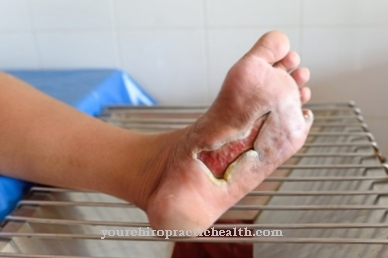At ingrown hairs it is hair that grows back into the skin through a curve. This phenomenon can occur anywhere that body hair is found. Hair ingrown is not dangerous, but it can lead to irritating and painful inflammation.
What is ingrown hair?

Experts understand an ingrown hair to be the growth of body hair into the skin. In children, hair ingrown almost never occurs; in adults, people who tend to have thick and curly hair are particularly affected.
This is particularly predestined for curved growth after hair removal, which can lead to ingrowth. Ingrown hairs tend to appear on parts of the body where many people remove the natural hair.
In men, the face and neck area are often affected; in both sexes the armpits as well as the genital and anal area. In addition to irritation of the skin, which is accompanied by redness and itching, the ingrown hair can lead to purulent inflammation.
causes
In many cases, the causes of ingrown hairs lie in previous hair removal by shaving or plucking, waxing or epilation.
When a hair is removed, the hair that grows back has a sharper edge than the previous one. This fact makes it easier to curve and then grow in the wrong direction. If the hair then gets stuck under the surface of the skin and continues to grow there, the typical irritation occurs. Dead skin cells are another possible cause.
These clog the hair follicle, forcing the hair to grow crookedly. Ingrown hairs can also be traced back to an overproduction of certain sex hormones. This can lead to increased hair growth and thus a higher risk of some of this hair growing in.
Diseases with this symptom
- Nasal furuncle
- Ear furuncle
- boil
Diagnosis & course
Ingrown hair can usually already be diagnosed by the person affected, as it leads to reddening of the skin, itching and bumps filled with pus.
If an affected person with these symptoms visits a doctor, he will examine the region of the body more closely and thus clearly identify the ingrown hair. In most cases, further examinations are not necessary. Inflammation caused by ingrown hairs is harmless, but it can be very uncomfortable and may also cause more pain.
In most cases it will go away on its own within a short time. If the person concerned scratches the inflamed area heavily, permanent scarring can occur. In dark-skinned people, the inflammation often leaves a dark discoloration of the respective area, which is also permanent.
Complications
Ingrown hairs can lead to inflammation, which in most cases is harmless. However, an unpleasant course with mild to severe pain and possibly further risks is also conceivable. Scratching the inflamed area can also lead to unsightly and possibly permanent scarring. A dark discoloration leaves the inflammation in people with dark skin. This can also be permanent.
Pustules, which often form on or around an ingrown hair, usually heal on their own after a short time. More rarely, the hair follicle of the ingrown hair is strongly irritated by staphylococci (type of bacteria). The consequence, however, is always a painful inflammation of the surrounding skin / tissue area. This in turn can lead to a boil, an abscess or even blood poisoning (sepsis).
If such a development occurs, the use of antibiotics is called for in order to counteract the spread with further health consequences. If the antibiotic treatment does not work, the last alternative is a small incision that allows the pus that has formed under the surface of the skin to drain away. So that no new inflammations form afterwards, absolute hygiene and a med. correct wound care is essential. As harmless as an ingrown hair initially appears, the health complications can be serious.
When should you go to the doctor?
If ingrown hair does not go away by itself or if your own measures are unsuccessful, it is advisable to go to a specialist. Ingrown hairs are annoying in the long run. They affect the appearance. Ingrown hairs also tend to become infected, as the body reacts defensively to the penetrating hair, which acts as a foreign body, via the inflammation.
The inflammation can be recognized by reddened, heated, swollen and sore skin in the area of the ingrown hair. The extent of the inflammation depends heavily on the condition of the skin and hair. Your own attempts to remove hair that has grown back into the skin should be avoided if there is an existing inflammation at the latest. Only the doctor is required here.
The dermatologist, as the responsible specialist, will remove the ingrown hairs using a sterile needle or a scalpel through a fine cut in the skin. The doctor also decides whether and which medication to prescribe. Experimentation with over-the-counter drugs is not recommended. Seeing a doctor is advisable for the simple reason that the possible inflammation caused by ingrown hairs unexpectedly becomes more severe than usual.
With his experience, the doctor can assess the threats - for example a boil, an abscess or even blood poisoning. Its competent countermeasures, implemented in good time, prevent permanent damage such as scars or dark skin discoloration.
Doctors & therapists in your area
Treatment & Therapy
If it comes to an ingrown hair, it is not necessary to see a doctor. Slight redness and inflammation that cause little discomfort do not necessarily have to be treated as they heal on their own.
Strong scratching or "pounding" should be avoided in any case in order to prevent possible scarring. If larger bumps develop that contain pus and cause pain, it is advisable to see a dermatologist. They will try to remove the ingrown hair using a scalpel or tweezers. If necessary, he will make a small incision, which will also remove the pus. A light local anesthetic is possible on request.
Subsequent cleaning of the skin area prevents any subsequent inflammation. The doctor can also prescribe anti-inflammatory drugs. These include steroids, for example, which are usually applied directly to the skin in the form of creams or ointments and are intended to relieve the swelling. Treatment with antibiotics is also conceivable.
These are either prescribed in the form of ointments or taken orally and help to heal the existing inflammation. As a preventive measure, the doctor can also prescribe so-called retinoids, which remove dead skin cells and thus prevent possible changes in skin pigmentation.
Outlook & forecast
If, for example, the hair grows again after a surgical shave, it can lead to ingrown hair. The person concerned often does not notice immediately that a hair is growing in. It can develop in circles under the skin and grow for several weeks before causing discomfort.
At some point, the sufferer discovers a painless swelling that looks strange. With luck, he can use tweezers because the encapsulated hair has made it to the surface due to lack of space. In this case, the prognosis is favorable. The small exit wound heals quickly after pulling out the ingrown hair. It is likely that such incidents will not occur again at the same point. A scar does not remain on the affected person.
In other cases, ingrown hairs can lead to inflammatory reddening of the skin and swelling relatively quickly. This can potentially happen on any part of the body that is covered in hair. If there is a reddened swelling without a recognizable hair in the center, it may be an ingrown hair instead of a hair root inflammation.
First of all, it is important to suppress the inflammation with medication. Failure to do this can result in boils or painful abscesses. This makes the prognosis of scar-free healing worse. The doctor may need to surgically open the boils or abscesses.
prevention
Ingrown hairs can be prevented if you keep a close eye on shaved or epilated areas of the body after hair removal.
Since hair grows relatively slowly, it is possible to recognize a curvature and thus an impending ingrowth as it develops. In this case, those affected should rub the skin with a warm cloth and a little alcohol to widen the pores. With the help of a sterilized needle or tweezers, careful attempts can then be made to change the direction of hair growth and thus prevent possible ingrowth.
If a hair has already grown in, you should not try to remove it yourself, as this can lead to further inflammation. If in doubt, a doctor should be consulted.
You can do that yourself
Ingrown hairs are often painful and unsightly. Those affected can take a number of measures to prevent the problem from occurring in the first place. Anyone who shaves face, arms and legs or other parts of the body should make sure to use high-quality blades that must not be worn. If the hair is not cut off but torn off, there is a risk that it will not just grow out of the skin, but will continue to grow under the epidermis. Hair tearing can also be prevented by using shaving foam.
If body hair is epilated, i.e. removed together with the root, there is also the risk that the hair will later grow back crookedly. If the hair's growth channel is blocked by flakes of skin or sebum, ingrown hairs can also occur. Those affected can prevent this with regular peelings or brush massages, which remove dead skin. These measures often expose the ingrown hairs again.
If mechanical methods are insufficient, ingrown hairs can also be treated with salicylic acid. Patients who constantly suffer from ingrown hairs should avoid tight-fitting clothing, as these can also hinder hair growth.

.jpg)



.jpg)







.jpg)

.jpg)
.jpg)











.jpg)